
The Ribblehead Viaduct or Batty Moss Viaduct carries the Settle–Carlisle railway across Batty Moss in the Ribble Valley at Ribblehead, in North Yorkshire, England. The viaduct, built by the Midland Railway, is 28 miles (45 km) north-west of Skipton and 26 miles (42 km) south-east of Kendal. It is a Grade II* listed structure. Ribblehead Viaduct is the longest and the third tallest structure on the Settle–Carlisle line.

Penistone is a market town and civil parish in the Metropolitan Borough of Barnsley, South Yorkshire, England, which had a population of 24,760 at the 2021 census. Historically in the West Riding of Yorkshire, it is 8 miles (13 km) west of Barnsley, 17 miles (27 km) north-east of Glossop, 14.2 miles (23 km) north-west of Sheffield, 27 miles (43 km) south-west of Leeds and 29 miles (47 km) east of Manchester in the foothills of the Pennines. The town is frequently noted on lists of unusual place names.

The Penistone Line is operated by Northern Trains in the West Yorkshire Metro and Travel South Yorkshire areas of northern England. It connects Huddersfield and Sheffield via Penistone and Barnsley, serving many rural communities. Metrocards can be used for travel between Huddersfield and Denby Dale and intermediate stations.

Wicker Arches form a 660-yard (600 m) long railway viaduct across the Don Valley in the City of Sheffield, England. They take their name from the thoroughfare Wicker, which passes through the main arch of the viaduct and was, until the completion of the Sheffield Parkway, the main route eastwards from the city to the M1. It is a Grade II* listed structure.
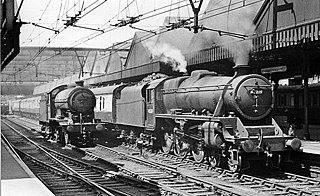
Sheffield Victoria was the main railway station in Sheffield, South Yorkshire, England, on the Great Central Railway,

Penistone railway station serves the town of Penistone, in the Metropolitan Borough of Barnsley, South Yorkshire, England. The current station, at the junction of the Woodhead Line and Penistone Line, opened in 1874; it replaced a station solely on the Woodhead Line, dating from the line's opening by the Sheffield, Ashton-Under-Lyne and Manchester Railway in 1845.

Lockwood railway station is a railway station in Huddersfield, England. It is situated 1.5 miles (2 km) south of Huddersfield station on the Penistone Line between Huddersfield and Sheffield. It serves the Lockwood district of Huddersfield, and services are provided by Northern.
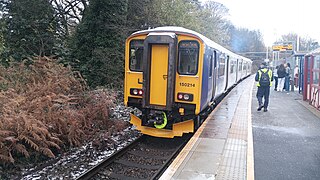
Denby Dale railway station serves the village of Denby Dale, in West Yorkshire, England and the surrounding area. It lies on the Penistone Line 9.5 miles (15 km) south east of Huddersfield and is operated by Northern.
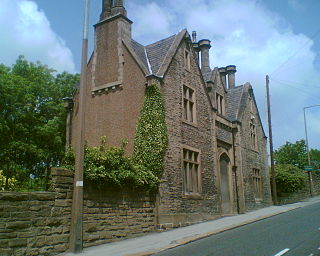
The Holmfirth branch line is a disused railway line that ran for 2 miles (3.2 km) from Brockholes to Holmfirth, in West Yorkshire, England. The line was built as double track as there were plans to extend the line up the Holme Valley.

Victoria Viaduct, originally known as the Victoria Bridge, is a stone arch rail viaduct spanning the River Wear about 1 mile (1.6 km) south-east of Washington in the City of Sunderland North East England. It was built as part of the Durham Junction Railway under the supervision of Thomas Elliot Harrison.

Morley Tunnel is a railway tunnel in West Yorkshire, England, situated between Morley and Batley railway stations on the Huddersfield line. From its northern end, it extends 3,369 yards (3,081 m), passing beneath Morley town centre, to its southern end.

Bowling Tunnel is a railway Tunnel on the Calder Valley line, south of Bradford in West Yorkshire, England. The Tunnel was completed in 1850 after some difficulty in construction, and allowed trains from the south to access the second railway terminus in the town of Bradford. The Tunnel remains open to railway traffic with trains between Halifax and Bradford Interchange using it.

Penistone Viaduct is a grade II listed railway viaduct that carries the Penistone Line over the River Don in Penistone, South Yorkshire, England. It is immediately north of Penistone station and was completed in 1850 to a design by John Hawkshaw. The viaduct was partially rebuilt in 1916 after one of the arches over the River Don collapsed.

Knaresborough Viaduct is a viaduct in the North Yorkshire town of Knaresborough, England. The viaduct carries the Harrogate line over the River Nidd in the town. The viaduct was supposed to have opened in 1848, but the first construction collapsed into the river very near to completion, which necessitated a new viaduct and delayed the opening of the line through Knaresborough by three years.

Dandry Mire Viaduct,, is a railway viaduct on the Settle & Carlisle line in Cumbria, England. It is just north of Garsdale station, 21 miles (34 km) from Settle, and 51 miles (82 km) south of Carlisle. When the Settle & Carlisle line was being built, the traversing of Dandry Mire was to have been by use of an embankment, but the bog swallowed all of the material poured into it, so a trench was dug instead, and a viaduct constructed. The viaduct, which is 227 yards (208 m) long and 50 feet (15 m) high, is still open to traffic on the railway, and is a prominent landmark at the head of Garsdale.
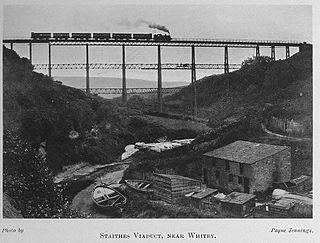
Staithes Viaduct was a railway bridge that straddled Staithes Beck at Staithes, Yorkshire, England. It was north of the closed Staithes railway station. It was known for an anemometer, a fitting to tell the signaller if winds across the viaduct were too strong for crossing trains.

The Clayton West branch line was a standard gauge passenger and freight railway near Huddersfield, in West Yorkshire, England. The line was built by the Lancashire and Yorkshire Railway, opening to traffic in September 1879. Many proposals were considered to extending the line eastwards towards Darton, and then connecting to Barnsley, but these never came to fruition. In 1963, both stations on the line,, were listed for closure under the Beeching cuts, but the branch survived as a passenger carrying railway until 1983. The branch also forwarded coal from two collieries adjacent to the line, which maintained a freight service on the branch up until closure.
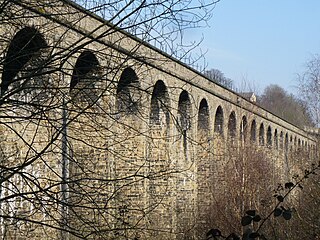
Lockwood Viaduct is a stone railway bridge that carries the Huddersfield to Penistone Line across the River Holme, in West Yorkshire, England. The viaduct is noted for its height,, leading one journalist to describe it as "One of the most stupendous structures of ancient or modern times." One local challenge has been to "lob" a cricket ball over the viaduct, with some claiming that they have. The viaduct was completed in 1848 and is now a grade II listed structure.

Wheatley Viaduct is a former railway bridge straddling the Hebble Brook on the northern side of Halifax, in West Yorkshire, England. The ten-arch viaduct was built as part of the Halifax High Level Railway that connected with the Queensbury lines complex of the Great Northern Railway between Halifax, Keighley and Bradford. The line was opened in 1890, and closed to all traffic in 1960.
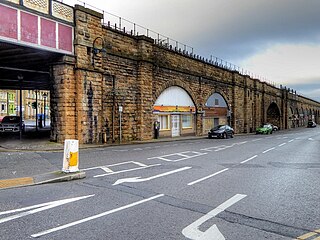
Huddersfield Viaduct is a railway bridge to the north-east of Huddersfield railway station in West Yorkshire, England. The viaduct carries the Huddersfield Line connecting Huddersfield with Dewsbury, Leeds, and York eastwards, and Manchester and Liverpool westwards. The viaduct was built to carry two lines, but was widened in the 1880s to take four tracks, and then reduced to two tracks in 1970. Huddersfield Viaduct is less well-known than other viaducts in the Kirklees area as they are higher, but Huddersfield Viaduct is the longest in the Kirklees district.






















